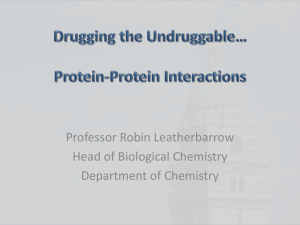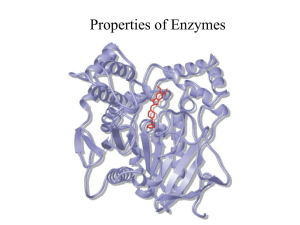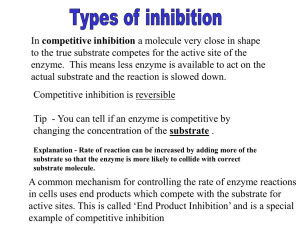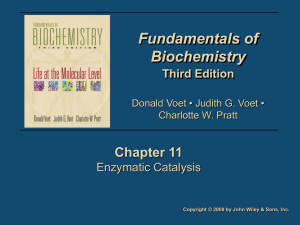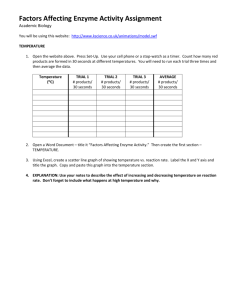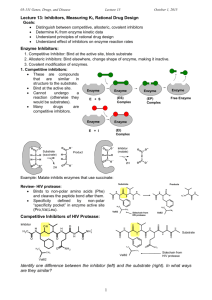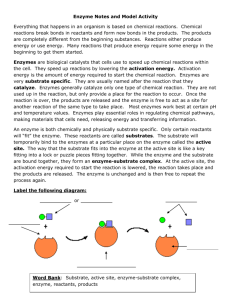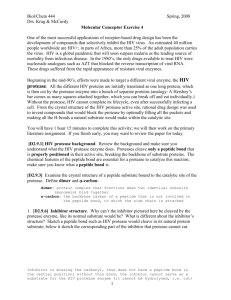Lecture 5 - Andrew.cmu.edu
advertisement
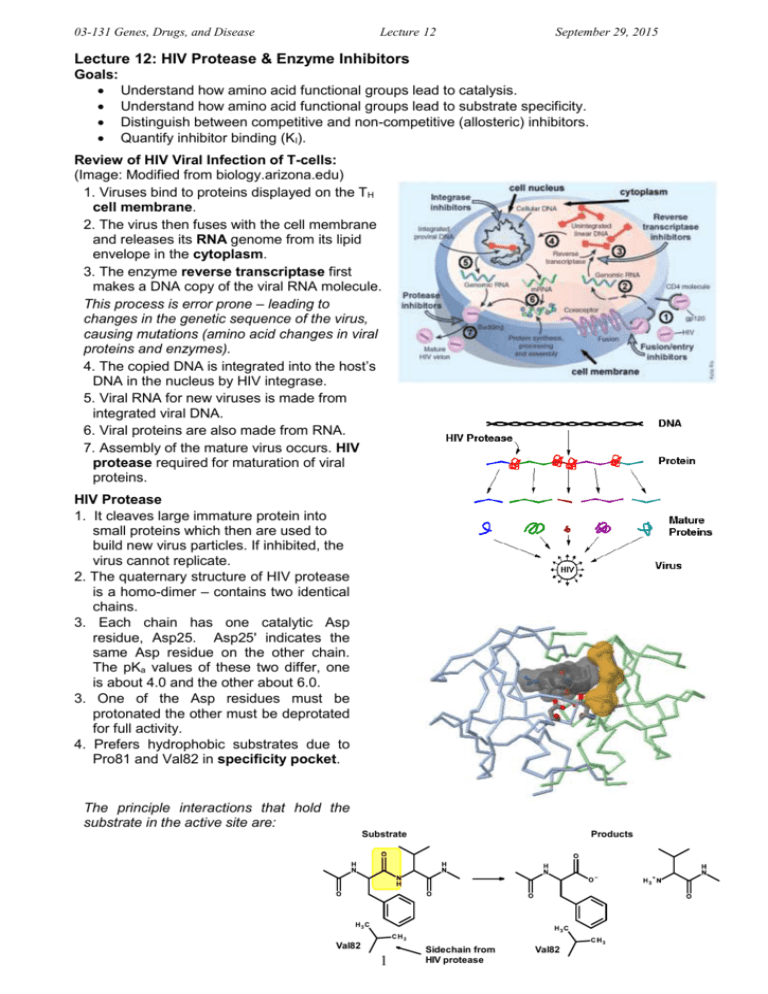
03-131 Genes, Drugs, and Disease Lecture 12 September 29, 2015 Lecture 12: HIV Protease & Enzyme Inhibitors Goals: Understand how amino acid functional groups lead to catalysis. Understand how amino acid functional groups lead to substrate specificity. Distinguish between competitive and non-competitive (allosteric) inhibitors. Quantify inhibitor binding (KI). Review of HIV Viral Infection of T-cells: (Image: Modified from biology.arizona.edu) 1. Viruses bind to proteins displayed on the TH cell membrane. 2. The virus then fuses with the cell membrane and releases its RNA genome from its lipid envelope in the cytoplasm. 3. The enzyme reverse transcriptase first makes a DNA copy of the viral RNA molecule. This process is error prone – leading to changes in the genetic sequence of the virus, causing mutations (amino acid changes in viral proteins and enzymes). 4. The copied DNA is integrated into the host’s DNA in the nucleus by HIV integrase. 5. Viral RNA for new viruses is made from integrated viral DNA. 6. Viral proteins are also made from RNA. 7. Assembly of the mature virus occurs. HIV protease required for maturation of viral proteins. HIV Protease 1. It cleaves large immature protein into small proteins which then are used to build new virus particles. If inhibited, the virus cannot replicate. 2. The quaternary structure of HIV protease is a homo-dimer – contains two identical chains. 3. Each chain has one catalytic Asp residue, Asp25. Asp25' indicates the same Asp residue on the other chain. The pKa values of these two differ, one is about 4.0 and the other about 6.0. 3. One of the Asp residues must be protonated the other must be deprotated for full activity. 4. Prefers hydrophobic substrates due to Pro81 and Val82 in specificity pocket. The principle interactions that hold the substrate in the active site are: Substrate Val82 1 Products Sidechain from HIV protease Val82 03-131 Genes, Drugs, and Disease Lecture 12 September 29, 2015 Reaction Mechanism of HIV Protease – Peptide Bond Hydrolysis: HIV Protease Specificity pocket Asp25' Asp25' Asp25' Asp25' (Products) Asp25 (Substrate) ES complex Asp25 (Substrate) Asp25 Asp25 Transition state Activated nucleophile EP complex Reaction Steps: 1. Substrate (protein) binds, Phe residue in the substrate recognized by specificity pocket (Pro81, Val82) – Note the peptide bond after the Phe will be cleaved. 2. Water enters, deprotonated by hydrogen ion transfer to Asp25’ 3. Negatively charged hydroxide ion attacks carbonyl carbon (electropositive), generating the high energy transition state (high energy because of the negative charge on the oxygen). 4. Electron moves back to carbon, and then from C-N bond to nitrogen, breaking the peptide bond. Key points: i) Sidechain COOH groups from two Aspartic acid residues are responsible for the chemical reaction. ii) The specificity pocket, which is part of the active site, forms complementary interactions with the substrate. Enzyme Inhibitors: 1. Competitive inhibitors: These are compounds that are similar in structure to the substrate. Therefore they bind at the active site, but cannot undergo a reaction (otherwise they would be substrates). Many drugs are competitive inhibitors. Enzyme Enzyme (ES) Complex E + S Enzyme (EP) Complex Enzyme Free Enzyme Enzyme (EI) Complex E + I 2. Enzyme Allosteric (non-competitive) Inhibitors: These do not bind at the active site, but Allosteric Inhibitor elsewhere. The change the shape of the enzyme (allo=different, steric=shape). By Enzyme changing the shape they can decrease the rate of reaction. Many drugs are allosteric inhibitors. E + I 2 Enzyme (EI) Complex 03-131 Genes, Drugs, and Disease Lecture 12 September 29, 2015 Competitive Inhibitors of HIV Protease: Substrate Val82 Sidechain from HIV protease Val82 Identify one key difference between the inhibitor (left) and the substrate (right). In what ways are they similar? Quantitative measure of Competitive Inhibitor Binding: [EI] [E] + [I] The dissociation constant for an inhibitor leaving the enzyme is defined as: KI [ E ][ I ] [ EI ] The KI is the amount of inhibitor required to ½ saturate the enzyme (in the absence of substrate). When [E] = [EI], KI = [I] If the [I] is less than KI less than 50% of the enzymes will have inhibitor bound. If the [I] is greater than KI more than 50% of the enzymes will have inhibitor bound. If the [I] is 10 x KI 90% of the enzymes will have inhibitor bound. If the inhibitor binds tightly, KI will be: If the inhibitor binds weakly, KI will be: Effect of Competitive Inhibitors on Enzyme Reaction Rates: Competitive inhibitors only inhibit at low substrate. When the substrate is high the inhibitor cannot Rate bind since both inhibitor and substrate bind to of Reaction the same place. The effect of the inhibitor on the reaction rate can be used to determine KI. [S] Expectations: Determine which interactions stabilize (ES) and (EI) complex based on structure. i. H-bonds (donors and acceptors) ii. van der Waals (complementary surfaces) iii. hydrophobic effect (non-polar) iv. electrostatic (unlike charges) Distinguish between competitive and allosteric inhibitors based on similarity to substrate. Understand effect of competitive inhibitors on reaction rate. Relationship between KI and strength of inhibitor binding. 3
